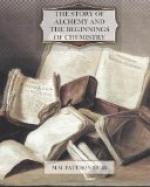The supposition that changes in the properties of substances are connected with changes in the numbers, movements, and arrangements of different kinds of minute particles, was used in a general way by many naturalists of the 17th and 18th centuries; but Dalton was the first to show that the data obtained by the analyses of compounds make it possible to determine the relative weights of the atoms of the elements.
Dalton used the word atom to denote the smallest particle of an element, or a compound, which exhibits the properties characteristic of that element or compound. He supposed that the atoms of an element are never divided in any of the reactions of that element, but the atoms of a compound are often separated into the atoms of the elements whereof the compound is composed. Apparently without knowing that the supposition had been made more than two thousand years before his time, Dalton was led by his study of the composition and properties of the atmosphere to assume that the atoms of different substances, whether elements or compounds, are of different sizes and have different weights. He assumed that when two elements unite to form only one compound, the atom of that compound has the simplest possible composition, is formed by the union of a single atom of each element. Dalton knew only one compound of hydrogen and nitrogen, namely, ammonia. Analyses of this compound show that it is composed of one part by weight of hydrogen and 4.66 parts by weight of nitrogen. Dalton said one atom of hydrogen combines with one atom of nitrogen to form an atom of ammonia; hence an atom of nitrogen is 4.66 times heavier than an atom of hydrogen; in other words, if the atomic weight of hydrogen is taken as unity, the atomic weight of nitrogen is expressed by the number 4.66. Dalton referred the atomic weights of the elements to the atomic weight of hydrogen as unity, because hydrogen is lighter than any other substance; hence the numbers which tell how much heavier the atoms of the elements are than an atom of hydrogen are always greater than one, are always positive numbers.
When two elements unite in different proportions, by weight, to form more than one compound, Dalton supposed that (in most cases at any rate) one of the compounds is formed by the union of a single atom of each element; the next compound is formed by the union of one atom of the element which is present in smaller quantity with two, three, or more, atoms of the other element, and the next compound is formed by the union of one atom of the first element with a larger number (always, necessarily, a whole number) of atoms of the other element than is contained in the second compound; and so on. From this assumption, and the Daltonian conception of the atom, it follows that the quantities by weight of one element which are found to unite with one and the same weight of another element must always be expressible as whole multiples of one number.




